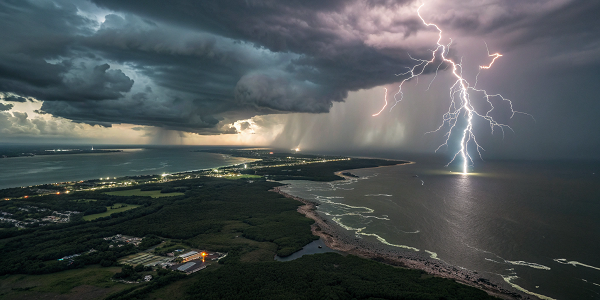August 29, 2025
From Katrina to Super Typhoons: The Most Insane Storms on Earth

Today, August 29, marks a somber anniversary: Hurricane Katrina made landfall in 2005. It's one of the most devastating storms in U.S. history, especially for New Orleans and the Gulf Coast. Millions were affected, lives were lost, and it's a stark reminder of nature's raw power.
Even years later, we still feel the echoes of what Katrina left behind - not just in physical damage, but in the stories of resilience and rebuilding.
Speaking of powerful storms, I figured, why not take this opportunity to dive into the fascinating world of hurricanes, cyclones, and typhoons? Trust me, there's a lot more to these spinning storms than just wind and rain, and some of it might surprise you.
First off, here's a little terminology lesson. You might've heard "hurricane," "typhoon," and "cyclone" thrown around interchangeably. Here's the scoop: they're basically the same kind of storm - massive rotating tropical storms - but the name depends on where they happen.
In the Atlantic and Northeast Pacific, we call them hurricanes. In the Northwest Pacific, they're typhoons. And in the South Pacific or Indian Ocean, they're cyclones. Geography matters even with storms!
Now, let's talk size. Hurricanes can be absolutely massive. Some can stretch over 600 miles in diameter, which is roughly the distance from Chicago to Cleveland. Imagine a storm that big barreling toward you, it's hard not to feel a little respect... or fear.
And the winds? The strongest hurricanes can produce winds over 180 mph, fast enough to toss cars around like toys in a sandbox. Makes you glad we have sturdy buildings and storm shelters.
Ever wonder how these storms get their names? It's actually a pretty interesting system. Back in the day, they were sometimes named after the saint's day on which they occurred, but now we have official lists managed by the World Meteorological Organization.
They rotate names every six years, alternating between male and female names. And if a hurricane is particularly destructive, like Katrina, that name gets retired out of respect. So, there will never be another Hurricane Katrina. That's kind of like a badge of infamy in the storm world.

Hurricanes also have a "calm center," which is the eye. It's a strange phenomenon because while the outer bands rage with wind and rain, the eye is often eerily calm and sometimes even sunny.
People have actually flown planes into these storms to study them, and pilots say it feels almost surreal - one minute you're in a hurricane's fury, the next you're in the quiet eye, and then back into chaos again.
One of the most mind-blowing things about hurricanes is how much rain they can dump. Some of the biggest storms have dropped over 50 inches of rain in a single location. That's over four feet of water.
And it's not just a puddle, it's floodwaters that can destroy homes, roads, and entire communities. Water is often more dangerous than the wind in these storms, which is why flood preparation is such a huge part of hurricane safety.
Here's a fun fact: hurricanes actually help regulate the Earth's temperature. They move heat from the tropics toward the poles, kind of like nature's air conditioning system. So, as destructive as they can be, they play a role in keeping our planet's climate balanced. Still, no one wants to be in the direct path!
Another interesting angle is how fast hurricanes can move. Some creep along at a leisurely 5 mph, while others race at 50 mph or more. That makes a huge difference in how much damage they cause.
Slow movers can dump massive amounts of rain in one spot, leading to catastrophic flooding, while faster ones tend to whip up high winds and can hit multiple areas quickly.
Did you know hurricanes can actually interact with each other? There's something called the Fujiwhara Effect, where two storms close to each other begin to rotate around a common center.
Sometimes they even merge into a single, more powerful storm. It's like Mother Nature's chaotic version of a dance party, and meteorologists get really excited (and a little nervous) when it happens.
Finally, while we often hear about hurricanes in the U.S., some of the strongest storms occur elsewhere. The Western Pacific sees "super typhoons" with wind speeds exceeding 200 mph. And the Indian Ocean has had cyclones that rank among the deadliest storms in history.
So even if you're not on the Gulf Coast, hurricanes - or their cousins—are worth paying attention to.
So, today, as we remember Hurricane Katrina and the lives it impacted, it's also a moment to appreciate just how fascinating these storms are. They're beautiful in a terrifying way, powerful in a way that commands respect, and complex in ways that even modern science is still trying to fully understand.
Stay safe out there, and if you're near the coast, maybe check the weather app just to be extra sure. And hey, now you've got a bunch of hurricane trivia ready to impress someone at your next conversation, or maybe just feel a little wiser about nature's wild side.
Until next time...
- Randy at Random Facts
Always Random. Never Boring